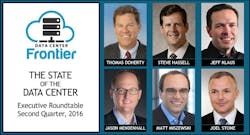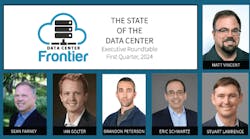Welcome to our fourth Data Center Executive Roundtable, a quarterly feature showcasing the insights of thought leaders on the state of the data center industry, and where it is headed. In our Second Quarter 2016 roundtable, we will examine four topics: trends in wholesale data center demand in 2016, renewable energy in the data center sector, rating the industry’s progress on energy efficiency, and how new technologies like the Internet of Things and virtual reality will impact demand for data center services.
Here’s a look at our distinguished panel:
- Steve Hassell served as CIO of Emerson before assuming the role of President of Emerson Network Power Data Center Solutions business in North America, where he oversees development, manufacturing, sales and service of the business’ portfolio of power, thermal management, software and converged solutions.
- Jason Mendenhall is Executive Vice President of Cloud for Switch SUPERNAP, a global technology solutions company, headquartered in Las Vegas.
- Thomas Doherty, Chief Operating Officer of Aligned Data Centers, who draws on over 35 years experience in real estate, design and construction
- Jeff Klaus is the General Manager of Intel Data Center Manager (DCM) Solutions, where he leads a global team that designs and builds Intel DCM, middleware that is integrated into Data Center Infrastructure Management (DCIM) consoles to increase data center power and thermal efficiency.
- Matt Miszewski is the Senior Vice President, Sales and Marketing at Digital Realty, who is responsible for overseeing the company’s sales and leasing efforts as well as marketing activities globally.
- Joel Stone is Senior Vice President and Chief Operating Officer of RagingWire Data Centers, one of the top wholesale data center providers in the U.S. and part of NTT Communications with 140 data centers worldwide
The conversation is moderated by Rich Miller, the founder and editor of Data Center Frontier. Each day this week we will present a Q&A with these executives on one of our key topics. We begin our discussion by looking at trends in trends in wholesale data center demand in 2016:
Data Center Frontier: In the first half of 2016 we’ve seen unusually strong demand for wholesale data center space from cloud builders and Internet enterprises. Is this a short-term phenomenon, or is cloud growth fueling a long-term shift toward larger requirements?
STEVE HASSELL, Emerson Network Power
Steve Hassell: This shift toward larger requirements has been occurring for the last several years and we expect it to continue. When you analyze the evolution of the data center, you can trace the emergence of the current “cloud” generation back to about 2011. That’s when we saw the shift from a focus on availability, cooling and flexibility, which predominated in the client/server generation, to the current focus on capacity, modularity, efficiency and integration, which mark the cloud generation.
IT is experiencing rapid growth from a wide variety of applications, ranging from big data to social media to mobile to IoT. These trends are pushing IT assets into new locations, driving network expansion, and simultaneously fueling the expansion to cloud through public, private, and hybrid models. Currently, demand is outpacing supply, forcing organizations to grab IT space wherever they can find it within the confines of the application’s latency limits. Cloud providers are moving quickly to close this gap through new development; however, the trends driving demand are still in their early phases and should fuel further growth.
THOMAS DOHERTY, Aligned Data Centers
Thomas Doherty: Cloud demand is here to stay. As the portfolio of enterprise data center facilities are challenged by higher densities and legacy systems unable to meet the variable storage and computer demands of today’s IT demands, we expect moving to the cloud will continue to be a growing, viable solution for businesses. Opportunities to reduce cost of ownership through a utility model for storage and compute, while substantial research efforts well underway to address security concerns and every increasing need for data center capacity bode well for continued movement to the cloud.
- Government spending $7.4B on cloud and saved over $5.5B
- International Data Group (IDG) reports:
- 48% of enterprises are moving to the cloud to replace on-premise, legacy technology today
- 46% are adopting cloud applications and platforms due to their speed of deployment
- 43% are focusing on lower total cost of ownership (TCO). 50% of mid-market organizations are adopting the cloud to gain business continuity
- Corp Technology reports:
- Productivity improvements
- 70% of businesses report that they’ve been able to reinvest funds back into their business as a result of moving to the cloud
- 59% of SMBs using cloud services report significant productivity benefits
- Security concerns: 94% of SMBs have experienced security benefits in the cloud that they didn’t have with their on-premises service
- Productivity improvements
We don’t see this trend slowing anytime soon. Cloud growth is shifting the industry and is here to stay.
MATT MISZEWSKI, Digital Realty
Matt Miszewski: More companies are becoming data companies – producing and consuming massive amounts of disparate data. As the amount of data grows, it is becoming a greater challenge for companies to cut through the clutter and extract meaningful insights. Now more than ever, there is an overwhelming demand for real-time data, enhanced agility and scalability for online applications, so data centers are becoming increasingly in demand and more complex.
We believe that this is the long-term growth trajectory for the industry, which is facilitating growth of the cloud and is bringing exciting new opportunities to an ever-expanding digital world.
Hybrid cloud strategies enable companies to gain control over their data. With hybrid cloud environments, enterprises can quickly and efficiently access, analyze and exchange data, especially as speed and performance are increasingly differentiators in the competitive tech market. There is growing recognition among business and IT leaders of incorporating hybrid cloud strategies for business success – and this will not die down anytime soon. The hybrid cloud is the end-state where every company is going to end up.
Data centers are forming the foundation for our digital world and provide the physical connections, infrastructure and networks for everything we access and communicate via the cloud. They provide the physical infrastructure needed to facilitate the connections between cloud providers and businesses, so it is no surprise that the market is seeing a strong demand for wholesale data center space. [clickToTweet tweet=”Digital Realty’s Matt Miszewski: Data centers are forming the foundation for our digital world.” quote=”Digital Realty’s Matt Miszewski: Data centers are forming the foundation for our digital world.”]
Jason Mendenhall: It’s difficult to predict the future of technology simply because most of the time it’s wrong and almost always underestimated. One thing that can be said is that its growth is primarily being driven at a regional level with the goal to bring cloud resources closer to customers. The dev-test use case for cloud is close to maturity, and for the past several years, enterprises have been determining the role that the large-scale clouds will play in their technology strategy. Early adopters have realized that large-scale public clouds are an ‘and’ not an ‘or’ in their overall approach to solving business problems. In many cases, they have determined that at a relatively small scale, a private cloud integrated with a public cloud achieves better economics and efficiencies than just selecting one or the other.
JASON MENDENHALL, Switch SUPERNAP
Keeping this approach in mind, the integration of large-scale public clouds with private infrastructure, or even private managed clouds, is becoming a driving force in the growth of cloud services. New cloud connectivity industries are evolving and organizations like the Cloud Native Computing Foundation (CNCF) are developing standards to support this type of architecture and large-scale providers are recognizing that having a regional presence is important. The most relevant element to develop from these innovations is the importance of the superscale technology ecosystem. By providing scale to support large-scale cloud providers, as well as world class data centers to support private deployments, they become the ideal provider of true hybrid deployments.
Another factor observed is the role data sovereignty is playing. Not only are large-scale providers looking to support low-latency hybrid solutions, but they are looking to ensure that regulations do not limit commerce. After England’s referendum to leave the EU, it’s clear that there is a psychology present that is driving further need for localized deployments.
Not to be ignored is the looming wave of connected devices that will begin to permeate the planet. Smart cities, autonomous systems, advanced manufacturing and the connected home will continue to drive the need for more infrastructure. At the core of all of this is the same infrastructure that has been used for decades: humans interacting with applications that run on operating systems that are connected to servers and storage that sit somewhere. For instance, IoT, mobile, web, client server, mainframe and more all operate under that same paradigm. The ‘somewhere’ is quickly becoming more critical from a resiliency, scale and efficiency standpoint and industry leaders are rapidly executing to meet that burgeoning need.[clickToTweet tweet=”The integration of public clouds with private infrastructure is a driving force in the growth of cloud services.” quote=”The integration of public clouds with private infrastructure is a driving force in the growth of cloud services.”]
Since advanced technology has been around, a continuous cycle of computing methods—centralized to distributed—has been observed. In each evolution, the role of centralized resources and distributed methods never really dissipates. In short, compute is evolving to act more like the real world. Similar to how human bodies house a protected, centralized location to make sense of sensory inputs along with localized processors and data collectors at the edge, technology infrastructure is evolving to make sense of this new connected world.
Joel Stone: To paraphrase Forrest Gump, “I think, it’s both – both are happening at the same time.”
JOEL STONE, RagingWIre
From a technology perspective, we are living in truly historic times. The cloud is a disruptive force that is changing our lives. Data centers are the home of the cloud.
Yes, these massive wholesale deployments of 5, 10, and even more megawatts may be part of short term response to the rapid adoption of cloud computing. But, these deals also represent a broader trend towards scale computing that occurs most efficiently in wholesale data centers.
These large wholesale deals are typically not installed completely on Day 1. They ramp up over time. Once established, these large footprint deployments will continue to grow. In addition I expect to see more 1-4 megawatt deals particularly to support enterprise companies as they migrate out of in-house data centers and into hybrid cloud environments.
JEFF KLAUS, Intel
Jeff Klaus: As it stands, more organizations are evaluating the costs and benefits associated with migrating to some type of colo or cloud space. With more tools available from consultants in this space, evaluation is easier based on specific organizational needs.
NEXT: Data centers and renewable energy: Which approaches hold the most promise?
Keep pace with the fact-moving world of data centers and cloud computing by following us on Twitter and Facebook, connecting with me on LinkedIn, and signing up for our weekly newspaper using the form below:






